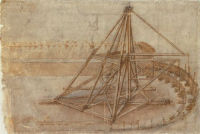The Body of Earth Click on the thumbnails to explore the trail
Read more about this trail (expand)
In his vision of the world, Leonardo saw the planet earth as a living entity, with all of its elements in a constant state of flux. As in nature form follows function, the landscape and all of its elements is seen as a product of the effects of nature that illustrates the bodily mechanisms of the earth.

- Enlarge
- Zoom & explore
-
Fol 4r - Machine for excavating canals © Biblioteca Ambrosiana - Auth. No Int 40/05
Codex Atlanticus 1478-1518
Leonardo’s work a military engineer for Cesare Borgia may account for his involvement in the Florentine Republic’s scheme to divert the course of the River Arno away from Pisa, with whom they were at war, on his return to Florence in 1503.
The scale of the project was enormous. Canals would have to be dug about 20 metres wide and 7 metres deep to carry the river 11 Km off its normal course. The government had calculated that the digging would require the employment of 2000 workers for about six months. Leonardo designed this large treadmill-powered digging machine in order to save time and effort. Huge buckets hang from pivot arms and convey the excavated soil to the sides of the canal. Once the buckets are emptied, each returns carrying a workman who acts as an ingenious counterweight to the soil in the other buckets.
The drawing is highly finished, implying that it may have been intended for presentation to the authorities. It is not known whether any of Leonardo’s machines were ever built. A section of the canal was begun, but the excavation collapsed and the project was abandoned.
In Leonardo's words
A head in profile with beautiful hair
certain bodies drawn in perspective
certain devices for ships
certain devices for water…
The Codex Atlanticus is the largest collection of Leonardo’s papers ever assembled, which was originally put together by the sculptor Pompeo Leoni. It takes its name from its large size, being comparable to an atlas.
The Codex Atlanticus reflects every aspect of Leonardo’s interests, including mechanical science, mathematics, astronomy, geography, botany chemistry and anatomy. The drawings represent a broad time-span and are varied in type. Studies relating to painting, sculptural, architectural and engineering projects are also included, such as the Adoration of the Magi altarpiece, the Sforza equestrian monument, and the dome of Milan Cathedral.
The manuscript is now arranged in 12 volumes, comprising of over 1100 miscellaneous drawings and fragments by Leonardo.
- Medium Pen and ink on paper
- Size 61 x 44 cm
- Location Biblioteca Ambrosiana











